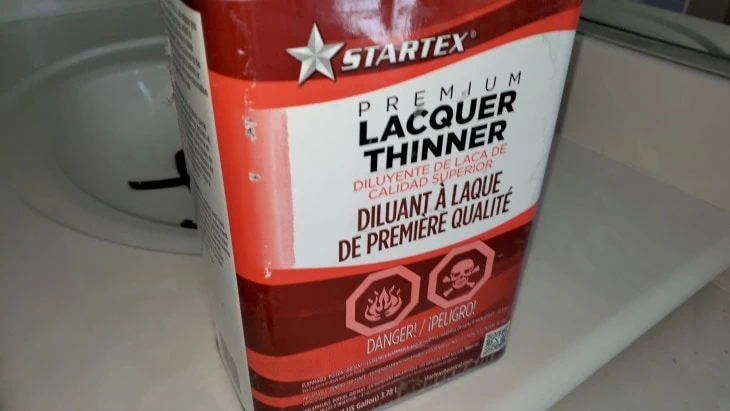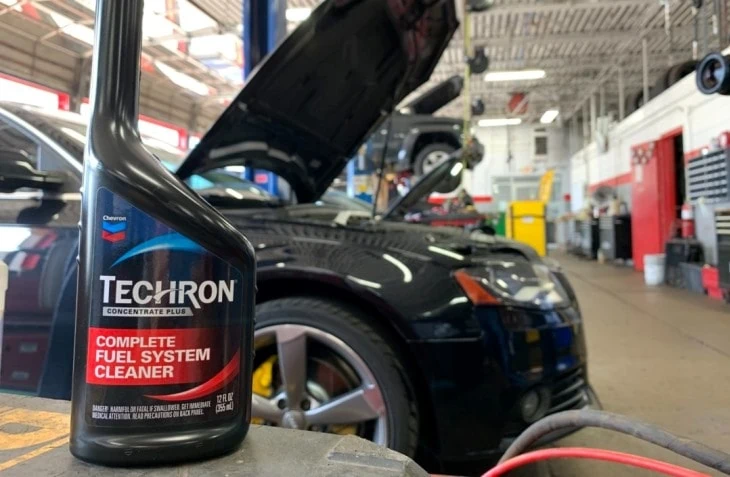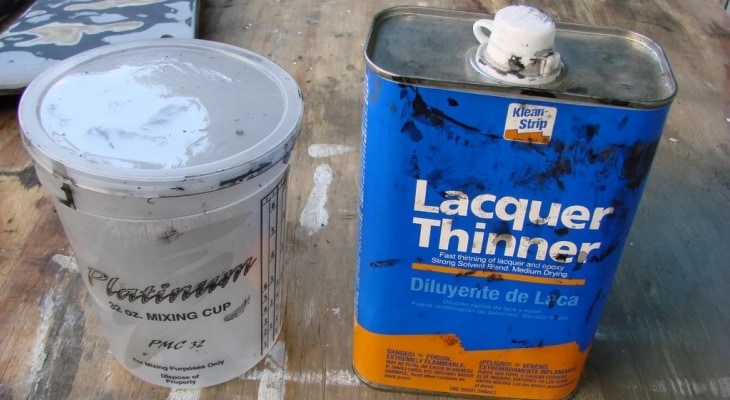Maybe you’ve heard of a trick for cleaning out your engine or exhaust and catalytic converter. Some people claim that running lacquer thinner or paint thinner through your car’s fuel system will help flush everything.
This couldn’t be further from the truth, and it could cost thousands to repair the damage it can cause.
Pouring lacquer thinner into the gas tank may indeed clean your engine and catalytic converter, but it can also damage them and everything else it comes in contact with. Paint thinner is very similar. Anything in your fuel system will make its way through your engine and exhaust, so it’s important to be careful with what you pour in.
Table of Contents
What Problem Are You Trying to Solve?

Before you do anything, you have to ask yourself what problem you want to fix by cleaning out the catalytic converter, or the engine. Is there a problem with the engine, or do you think something is wrong with the exhaust? Knowing the issue will give you the best indication of where to start.
Maybe there is no problem at all, and you just want to keep your car in tip-top shape. You should be proud of yourself for this because many people do not take the best care of their vehicle. You’re already ahead of the game with this mindset.
Engine Troubles
Be it a misfire, stalling concern, or lack of power, engine issues are always frustrating. Unfortunately, a myriad of things can make your engine underperform like this, so it’s important to accurately determine the problem before attempting a repair.
What can a cleaner in the gas tank do for an engine? This relatively small list involves cleaning off the dirty backsides of valves, intake ports in the cylinder head, and possibly the tops of the pistons. All this should be taken with a grain of salt, however, as these parts would have to be incredibly filthy for a cleaner to help.
Fuel System Issues
Your car’s fuel system is absolutely vital to keeping your engine going strong. Without a working fuel system (and the fuel itself), the engine is just a big chunk of metal.
In the fuel system, you have the tank, pump, lines, and injectors. There is also a fuel filter and the level sensor that tells you how much gas you have. Any of these can get clogged or dirty, causing them to not function properly. This is where a cleaner in the fuel tank can really help out.
The Exhaust and Cats

Finally, we get to the exhaust. This is a very simple system but it can cause a lot of trouble. The manifold carries your engine’s exhaust gasses to the catalytic converter. The converter cleans the gasses up for emissions and the muffler and tailpipe carry it the rest of the way out.
In the case of your exhaust system, if something is dirty or clogged, it doesn’t need to be cleaned. It needs to be replaced. This is especially true with the oxygen sensors and the catalytic converter, as any cleaner strong enough to unclog it will also destroy it.
It’s tempting to hope that pouring something in the tank will clean everything up and resolve an issue you’re having. Most of the time, however, it isn’t that simple. As you can see, there is a lot that can go wrong in your car, so it’s really best to properly find your problem and fix it directly.
What Happens If You DO Use Lacquer Thinner in the Gas Tank?

Before I go any further, I want to make sure you understand one thing: using lacquer or paint thinner to clean any part of your fuel system, engine, exhaust or catalytic converter will cause damage! Please don’t do it!
I’ll cover everything from the filler neck to the catalytic converter and show you what can go wrong. Lacquer thinner is extremely strong and aggressive, made to help break down the plastics and resins used in lacquer. Guess what… That’s a lot of the same kind of material found in your fuel system!
It’s worth noting that paint thinner is NOT as strong as lacquer thinner. That said, the principles are the same, and it can cause the same kind of damage.
Fuel System Degradation
Plastics are being used in cars more and more due to their weight savings. MOST of the fuel system itself is plastic these days. This can include the filler neck itself, the fuel tank, the fuel pump housing and fuel lines.
Even the fuel filter and injectors are often at least partially made of plastic, not to mention nearly all of the o-rings and seals. Imagine any of these things melting away from lacquer thinner dissolving them on a chemical level. You’d have a serious fire hazard on your hands.
Potential for Engine Damage
Your engine is made to burn gasoline (or maybe diesel if it’s a diesel engine). Using a thinner is going to change the octane rating of the gas in your car. Any changes to this will affect how the computer controls your engine.
With the computer out of whack, anything can happen. It may start adding too much or too little fuel or changing the spark timing too much. At best you could have an engine that constantly stalls, and worst-case scenario it could develop a knock and cause severe damage.
One more thing to remember is how sensitive the piston rings are. They have to seal a tremendous amount of pressure in the combustion chamber all while helping to keep the cylinder walls lubricated. If a thinner gets in there, you have the possibility of ruining the rings or stripping all the lubrication off the cylinder walls.
Exhaust, Converter, and Sensors
As I mentioned before, whatever is in your fuel will affect the engine and exhaust as well. Paint thinner may burn away in the engine, but lacquer thinner has a very good chance of getting all the way to your exhaust without burning up.
If this is the case, your oxygen sensors are going to go haywire. They are extremely sensitive, and even just a little thinner getting into them could destroy them for good.
Similarly, the converter is not designed to withstand something as strong as a paint or lacquer thinner. Even if raw gasoline gets into the converter it can completely tear it apart, so it’s a very safe bet you’ll be buying a new converter if any kind of thinner comes into contact with it.
What Cleaners Are Safe in the Gas Tank?

Some advice I have as we close is to always do research before putting something new in your gas tank. There are several safe and effective cleaners out there you can use, and every auto parts store will have them.
In my personal experience, Techron is one of the best you can use. Whether you’re trying to clean up some sticking injectors or level sensors, or just want to keep things as clean as possible, it does a great job. Other cleaners worth checking out are this one from Seafoam or this one from Lucas.
Remember, always follow the instructions on the bottle, and save the thinners for arts and crafts!


If you completely take out the Catalytic Converter and clean it outside the vehicle, what would you recommend? I’ve tried Vinegar and Bicarbonate with hot water. Soaked the innards overnight but very little success. The CC must be totally clogged.
Any advice would be appreciated.